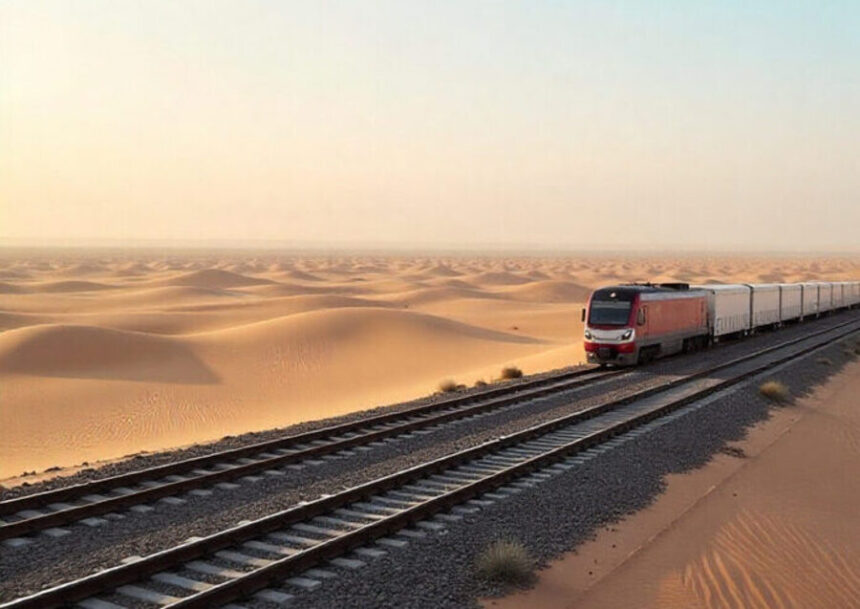Printed on
October 26, 2025
UAE and Oman have signed a historic settlement to ascertain a cross-border rail hall linking Abu Dhabi with the Omani metropolis of Sohar. This landmark undertaking is about to drive financial progress and sustainability throughout the Gulf area by enhancing commerce effectivity, lowering emissions, and bettering regional connectivity. By offering a direct and environmentally-friendly transportation route for key items, the rail hyperlink will strengthen financial ties between the 2 nations and set the stage for long-term collaboration, aligning with each nations’ sustainability targets and financial diversification methods.
In a groundbreaking growth, the UAE and Oman have formalized an settlement to construct a freight rail connection that may hyperlink Abu Dhabi with the Omani port metropolis of Sohar. This new rail hall is about to redefine commerce and logistics within the Gulf area, bettering connectivity, boosting regional cooperation, and making transport extra environment friendly and environmentally pleasant.
A New Period in Gulf Logistics
The newly established rail service, operated by Noatum Logistics and Hafeet Rail, is projected to move as much as 193,200 Twenty-Foot Equal Models (TEUs) yearly. With seven weekly providers, every prepare will carry 276 TEUs, making it a dependable and environment friendly strategy to transport important items, together with shopper gadgets, meals merchandise, and prescribed drugs. This rail line will present a direct route between Abu Dhabi, a key logistics hub within the UAE, and Sohar, one in all Oman’s main industrial cities.
By chopping down on journey time between the 2 cities, the rail hyperlink will considerably improve the effectivity of motion, permitting companies to scale back delays and higher meet the rising calls for of the market. This undertaking can be poised to decrease the area’s carbon footprint by shifting a considerable portion of transport from vans to trains, that are much more energy-efficient and environmentally pleasant.
Selling Sustainability and Financial Diversification
Each the UAE and Oman have been more and more targeted on sustainability as a part of their long-term financial plans. The brand new rail undertaking is an important step of their efforts to scale back their reliance on street transport, which is a serious contributor to carbon emissions. By transitioning extra freight to rail, each nations are aligning their logistics networks with world sustainability targets whereas concurrently enhancing the competitiveness of their economies.
Along with lowering emissions, the rail hall can be anticipated to supply a less expensive resolution for shifting items. This shift in the direction of rail will decrease working prices for companies whereas making a greener, extra sustainable provide chain throughout the Gulf.
Strengthening Financial Ties Between the UAE and Oman
This rail hyperlink will considerably improve commerce and logistics between the UAE and Oman, straight connecting two of the area’s most strategic financial hubs. The hall will enhance the circulation of products, making cross-border commerce between the 2 nations extra seamless and environment friendly. With enhanced infrastructure in place, the Gulf area is about to see a lift in its standing as a worldwide commerce middle.
By facilitating smoother transportation between Abu Dhabi and Sohar, the rail service will strengthen the financial ties between the 2 nations. It should present new alternatives for companies, improve the reliability of provide chains, and pave the best way for additional integration of Gulf economies. The transfer represents a key step towards a extra interconnected area the place commerce flows freely and effectively throughout borders.
Boosting Regional Infrastructure and Future-Proofing Logistics
The UAE-Oman rail hall is about to enrich current transport infrastructure within the area. For instance, Noatum Logistics’ shuttle service between Khalifa Port and Fujairah Terminals, which launched in 2024, is a part of the broader initiative to reinforce regional logistics capabilities. The rail service will combine with these current operations, guaranteeing a seamless circulation throughout the Gulf, with future growth plans set to help even higher capability.
This integration of rail with ports and different transportation networks will future-proof the Gulf’s logistics infrastructure, making it higher outfitted to deal with rising commerce volumes and evolving market calls for. The undertaking can even open up alternatives for different infrastructure developments, positioning the area for continued progress and growth within the world commerce market.
A Sustainable Future for the Gulf’s Logistics Sector
The UAE-Oman rail hall is poised to turn out to be a key a part of the area’s sustainability technique. With fuel-efficient trains and decrease emissions in comparison with street transport, the rail service will help each nations of their efforts to fulfill their environmental targets. The rail line can even scale back site visitors congestion and street put on, making it a extra dependable and cost-effective resolution for the long run.
This initiative is just not solely a win for the logistics sector but in addition for the broader economies of the UAE and Oman. By making a extra sustainable and environment friendly transportation community, the rail hall will assist enhance financial cooperation, promote commerce, and improve the Gulf’s world competitiveness. The undertaking is a testomony to the area’s dedication to financial diversification, sustainability, and regional collaboration.
UAE and Oman have signed a historic settlement to create a cross-border rail hall, boosting financial progress and sustainability by enhancing commerce effectivity and regional connectivity.
Because the rail hall turns into operational, it is going to function a mannequin for future cross-border infrastructure initiatives, highlighting the significance of environment friendly transport networks in supporting financial progress and sustainability. This growth marks a major milestone within the ongoing modernization of the Gulf’s logistics infrastructure and units the stage for much more revolutionary initiatives within the years to come back.








